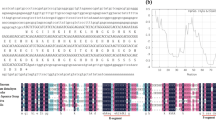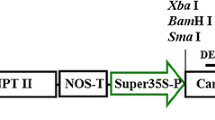Abstract
Dehydrins, a subfamily of group 2 LEA proteins, are intrinsically unstructured plant proteins that accumulate in the late stages of seed development and in vegetative tissues subjected to water deficit, salinity, low temperature, or abscisic acid treatment. In this study, we isolated and characterized ZmDHN2b, a maize dehydrin gene. The genomic organization of the ZmDHN2b gene and its expression in maize seedlings were analyzed. To investigate the function of ZmDHN2b, we generated transgenic tobacco plants constitutively overexpressing ZmDHN2b. Ectopic expression of ZmDHN2b in tobacco accelerated seed germination and seedling growth at 15°C. Furthermore, ZmDHN2b-overexpressing lines had lower levels of cold-induced malondialdehyde and less electrolyte leakage than wild-type tobacco at 4°C. These results demonstrated that ZmDHN2b was involved in plant responses to low temperature.






Similar content being viewed by others
Abbreviations
- ABA:
-
Abscisic acid
- DHN:
-
Dehydrin
- GA:
-
Gibberellic acid
- H2O2 :
-
Hydrogen peroxide
- JA:
-
Jasmonic acid
- LEA:
-
Late embryogenesis abundant
- ORF:
-
Open reading frame
- PCR:
-
Polymerase chain reaction
- pI:
-
Isoelectric point
- SA:
-
Salicylic acid
- SDS-PAGE:
-
Sodium dodecyl sulfate–polyacrylamide gel electrophoresis
- TBA:
-
Thiobarbituric acid
- TCA:
-
Trichloroacetic acid
- WT:
-
Wild type
References
Allagulova CR, Gimalov FR, Shakirova FM, Vakhitov VA (2003) The plant dehydrins: structure and putative functions. Biochemistry (Mosc) 68:945–951
Alsheikh MK, Svensson JT, Randall SK (2005) Phosphorylation regulated ion-binding is a property shared by the acidic subclass dehydrins. Plant Cell Environ 28:1114–1122
Bae EK, Lee H, Lee JS, Noh EW (2009) Differential expression of a poplar SK2-type dehydrin gene in response to various stresses. BMB Rep 42:439–443
Battaglia M, Olvera-Carrillo Y, Garciarrubio A, Campos F, Covarrubias AA (2008) The enigmatic LEA proteins and other hydrophilins. Plant Physiol 148:6–24
Borovskii GB, Stupnikova IV, Antipina AI, Vladimirova SV, Voinikov VK (2002) Accumulation of dehydrin-like proteins in the mitochondria of cereals in response to cold, freezing, drought and ABA treatment. BMC Plant Biol 2:5
Campbell SA, Close TJ (1997) Dehydrins: genes, proteins, and associations with phenotypic traits. New Phytol 137:61–74
Close TJ (1996) Dehydrins: emergence of a biochemical role of a family of plant dehydration proteins. Physiol Plant 97:795–803
Close TJ (1997) Dehydrins: a commonalty in the response of plants to dehydration and low temperature. Physiol Plant 100:291–296
Danyluk J, Perron A, Houde M, Limin A, Fowler B, Benhamou N, Sarhan F (1998) Accumulation of an acidic dehydrin in the vicinity of the plasma membrane during cold acclimation of wheat. Plant Cell 10:623–638
Goday A, Jensen AB, Culianez-Macia FA, Mar Alba M, Figueras M, Serratosa J, Torrent M, Pages M (1994) The maize abscisic acid-responsive protein Rab17 is located in the nucleus and interacts with nuclear localization signals. Plant Cell 6:351–360
Hara M, Terashima S, Fukaya T, Kuboi T (2003) Enhancement of cold tolerance and inhibition of lipid peroxidation by citrus dehydrin in transgenic tobacco. Planta 217:290–298
Hara M, Fujinaga M, Kuboi T (2004) Radical scavenging activity and oxidative modification of citrus dehydrin. Plant Physiol Biochem 42:657–662
Hara M, Shinoda Y, Tanaka Y, Kuboi T (2009) DNA binding of citrus dehydrin promoted by zinc ion. Plant Cell Environ 32:532–541
Heyen BJ, Alsheikh MK, Smith EA, Torvik CF, Seals DF, Randall SK (2002) The calcium-binding activity of a vacuole-associated, dehydrin-like protein is regulated by phosphorylation. Plant Physiol 130:675–687
Houde M, Dallaire S, N’Dong D, Sarhan F (2004) Overexpression of the acidic dehydrin WCOR410 improves freezing tolerance in transgenic strawberry leaves. Plant Biotechnol J 2:381–387
Jensen AB, Goday A, Figueras M, Jessop AC, Pages M (1998) Phosphorylation mediates the nuclear targeting of the maize Rab17 protein. Plant J 13:691–697
Koag MC, Fenton RD, Wilkens S, Close TJ (2003) The binding of maize DHN1 to lipid vesicles. Gain of structure and lipid specificity. Plant Physiol 131:309–316
Koag MC, Wilkens S, Fenton RD, Resnik J, Vo E, Close TJ (2009) The K-segment of maize DHN1 mediates binding to anionic phospholipid vesicles and concomitant structural changes. Plant Physiol 150:1503–1514
Kovacs D, Kalmar E, Torok Z, Tompa P (2008) Chaperone activity of ERD10 and ERD14, two disordered stress-related plant proteins. Plant Physiol 147:381–390
Kruger C, Berkowitz O, Stephan UW, Hell R (2002) A metal-binding member of the late embryogenesis abundant protein family transports iron in the phloem of Ricinus communis L. J Biol Chem 277:25062–25069
Li R, Brawley SH, Vakhitov VA (1998) Proteins immunologically related to dehydrins in fucoid algae. J Phycol 34:642–650
Li D, Shen J, Wu T, Xu Y, Zong X, Li D, Shu H (2008) Overexpression of the apple alcohol acyltransferase gene alters the profile of volatile blends in transgenic tobacco leaves. Physiol Plant 134:394–402
Liu L, Hu X, Song J, Zong X, Li D, Li D (2009) Over-expression of a Zea mays L. protein phosphatase 2C gene (ZmPP2C) in Arabidopsis thaliana decreases tolerance to salt and drought. J Plant Physiol 166:531–542
Mehta PA, Rebala KC, Venkataraman G, Parida A (2009) A diurnally regulated dehydrin from Avicennia marina that shows nucleo-cytoplasmic localization and is phosphorylated by Casein kinase II in vitro. Plant Physiol Biochem 47:701–709
Mtwisha L, Brandt W, McCready S, Lindsey GG (1998) HSP 12 is a LEA-like protein in Saccharomyces cerevisiae. Plant Mol Biol 37:513–521
Mueller JK, Heckathorn SA, Fernando D (2003) Identification of a chloroplast dehydrin in leaves of mature plants. Int J Plant Sci 164:535–542
Plana M, Itarte E, Eritja R, Goday A, Pages M, Martinez MC (1991) Phosphorylation of maize RAB-17 protein by casein kinase 2. J Biol Chem 266:22510–22514
Puhakainen T, Hess MW, Makela P, Svensson J, Heino P, Palva ET (2004) Overexpression of multiple dehydrin genes enhances tolerance to freezing stress in Arabidopsis. Plant Mol Biol 54:743–753
Riera M, Figueras M, Lopez C, Goday A, Pages M (2004) Protein kinase CK2 modulates developmental functions of the abscisic acid responsive protein Rab17 from maize. Proc Natl Acad Sci USA 101:9879–9884
Rodriguez EM, Svensson JT, Malatrasi M, Choi DW, Close TJ (2005) Barley Dhn13 encodes a KS-type dehydrin with constitutive and stress responsive expression. Theor Appl Genet 110:852–858
Rorat T (2006) Plant dehydrins–tissue location, structure and function. Cell Mol Biol Lett 11:536–556
Rorat T, Grygorowicz WJ, Irzykowski W, Rey P (2004) Expression of KS-type dehydrins is primarily regulated by factors related to organ type and leaf developmental stage during vegetative growth. Planta 218:878–885
Rorat T, Szabala BM, Grygorowicz WJ, Wojtowicz B, Yin Z, Rey P (2006) Expression of SK3-type dehydrin in transporting organs is associated with cold acclimation in Solanum species. Planta 224:205–221
Saavedra L, Svensson J, Carballo V, Izmendi D, Welin B, Vidal S (2006) A dehydrin gene in Physcomitrella patens is required for salt and osmotic stress tolerance. Plant J 45:237–249
Sanchez-Ballesta MT, Jesus Rodrigo M, Teresa Lafuente M, Granell A, Zacarias L (2004) Dehydrin from citrus, which confers in vitro dehydration and freezing protection activity, is constitutive and highly expressed in the flavedo of fruit but responsive to cold and water stress in leaves. J Agric Food Chem 57:1950–1957
Schnable PS, Ware D, Fulton RS, Stein JC, Wei F, Pasternak S, Liang C, Zhang J, Fulton L, Graves TA et al (2009) The B73 maize genome: complexity, diversity, and dynamics. Science 326:1112–1115
Shih MD, Hoekstra FA, Hsing YIC (2008) Late embryogenesis abundant proteins. Adv Bot Res 48:211–255
Sun X, Yuan S, Lin HH (2006) Salicylic acid decreases the levels of dehydrin-like proteins in Tibetan hulless barley leaves under water stress. Z Naturforsch C 61:245–250
Thomashow MF (1999) Plant cold acclimation: freezing tolerance genes and regulatory mechanisms. Annu Rev Plant Physiol Plant Mol Biol 50:571–599
Tunnacliffe A, Wise MJ (2007) The continuing conundrum of the LEA proteins. Naturwissenschaften 94:791–812
Vilardell J, Mundy J, Stilling B, Leroux B, Pla M, Freyssinet G, Pages M (1991) Regulation of the maize rab17 gene promoter in transgenic heterologous systems. Plant Mol Biol 17:985–993
Welling A, Rinne P, Vihera-Aarnio A, Kontunen-Soppela S, Heino P, Palva ET (2004) Photoperiod and temperature differentially regulate the expression of two dehydrin genes during overwintering of birch (Betula pubescens Ehrh.). J Exp Bot 55:507–516
Zhang Y, Li J, Yu F, Cong L, Wang L, Burkard G, Chai T (2006) Cloning and expression analysis of SKn-type dehydrin gene from bean in response to heavy metals. Mol Biotechnol 32:205–218
Zhu B, Choi DW, Fenton R, Close TJ (2000) Expression of the barley dehydrin multigene family and the development of freezing tolerance. Mol Gen Genet 264:145–153
Zong XJ, Li DP, Gu LK, Li DQ, Liu LX, Hu XL (2009) Abscisic acid and hydrogen peroxide induce a novel maize group C MAP kinase gene, ZmMPK7, which is responsible for the removal of reactive oxygen species. Planta 229:485–495
Acknowledgments
This work was supported by the National Natural Science Foundation of China (Nos. 31071337 and 30871457) and the State Key Basic Research and Development Plan of China (No. 2009CB118500) and also was supported by the Program for Changjiang Scholars and Innovative Research Team in University (No. IRT0635).
Author information
Authors and Affiliations
Corresponding author
Electronic supplementary material
Below is the link to the electronic supplementary material.
Rights and permissions
About this article
Cite this article
Xing, X., Liu, Y., Kong, X. et al. Overexpression of a maize dehydrin gene, ZmDHN2b, in tobacco enhances tolerance to low temperature. Plant Growth Regul 65, 109–118 (2011). https://doi.org/10.1007/s10725-011-9580-3
Received:
Accepted:
Published:
Issue Date:
DOI: https://doi.org/10.1007/s10725-011-9580-3




